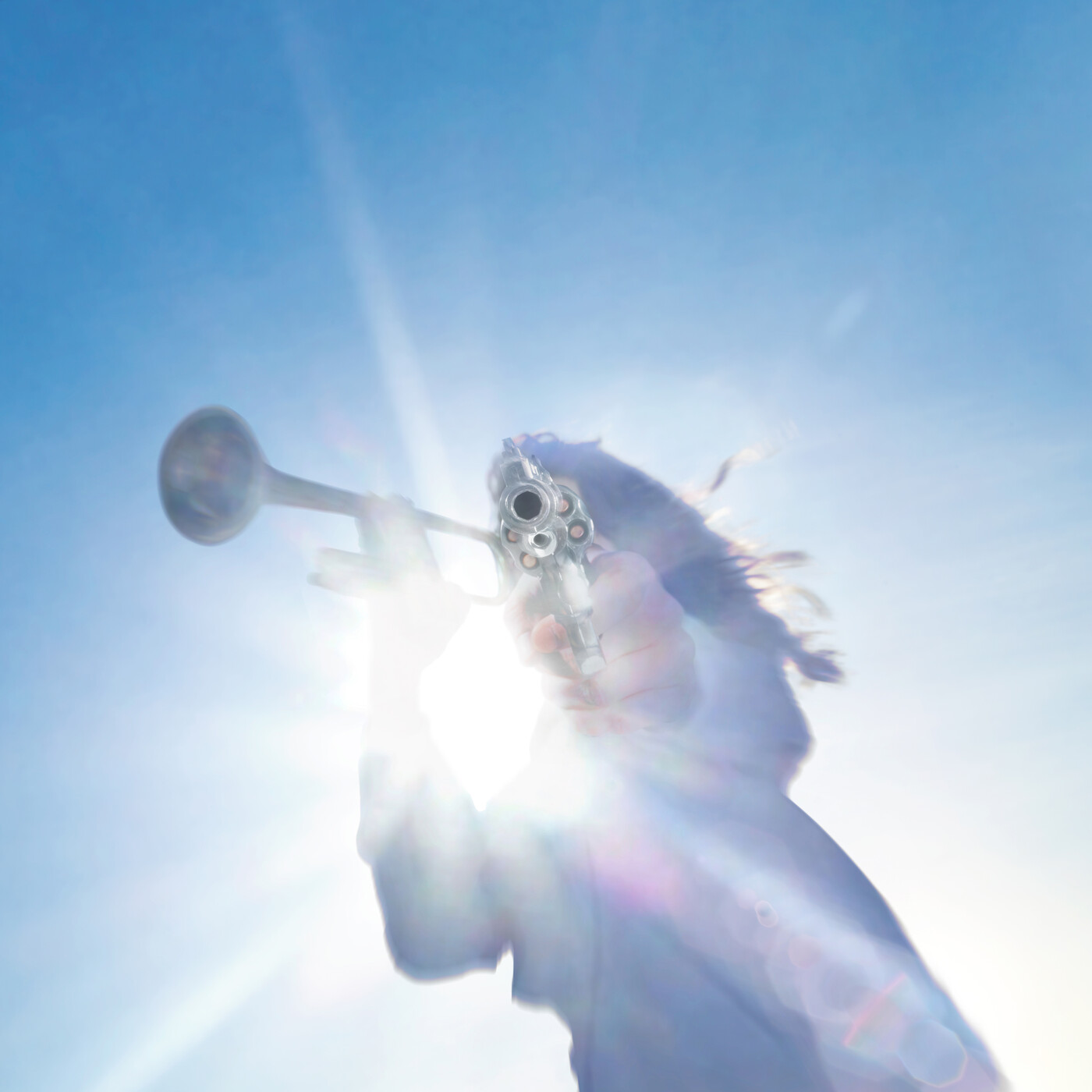Two minutes and 10 seconds into "Not In Kansas," the National disappear. It's a key track on their new album, I Am Easy To Find, and you could imagine the ways a younger version of the band may have treated the arrangement; you could picture an successor to "England," a song slowly ratcheting up tension for the sort of big cathartic conclusion this group's become known for. This isn't what happens with "Not In Kansas," and it proves a striking moment. The music, Matt Berninger -- they all fade away, replaced by a chorus of female vocalists, Gail Ann Dorsey, Lisa Hannigan, and Kate Stables. They are singing an interpolation of a '90s song called "Noble Experiment" by Thinking Fellers Union Local 282. But it sounds like an actual hymn. Across its sprawling hour-plus runtime, I Am Easy To Find is full of these tiny surprises.
The National are in a peculiar place as a band. Eight albums in, certain trademarks are ingrained in their work. They have built their name on a kind of patient fire, angst blooming into exorcisms, an artful and quiet version of anthems and refrains born for a disenchanted and listless generation. Though their broader notoriety and acclaim was gradual and hard-fought, the band has now existed for two decades. They've firmly established their identity, and their name immediately inspires an array of associations. At this point, on some level, we think we know what to expect from them.
That is not a destination every band reaches. To get there, you have to survive years of the industry. You have to achieve a certain baseline of success. It's a position of luxury and security but also of possible stagnation -- or at least perceived stagnation. The foundation of their legacy is already solid, having become one primary name in a very small collection of indie or rock artists that have crossed over to some kind of mainstream awareness in the last 10 years. Their fans are committed, likely to find resonance in any kind of archetypal new National song that comes their way; on the other hand, the band is far past the point at which they'd likely be able to convert their detractors. And so with each new National album, a fork in the road now opens up: Implode their identity with wild experiments and potentially falter, or stick to proven formulas and settle into a kind of satisfying-but-not-overwhelming platonic ideal of themselves. Always the careful, precise craftsmen, the National have located some kind of middle ground on I Am Easy To Find.
In that sense, I Am Easy To Find is a spiritual (though not necessarily always sonic) continuation of 2017's Sleep Well Beast. On that album, you had quintessentially National songwriting -- "Nobody Else Will Be There," "Day I Die," "Carin At The Liquor Store" -- that rivaled or surpassed the pre-existing favorites in similar molds. Those, however, sat alongside some truly adventurous material, the band adopting a claustrophobic, electronic-textured sound for songs like "I'll Still Destroy You" or the album's Radiohead-esque title track. I Am Easy To Find, too, features several songs that will feel like returning home for longtime National fans, and plenty of unexpected turns along the way -- not least of which is that, after the achievement and density of Sleep Well Beast, there is another new National album in under two years' time.
"The new National album." That's a phrase, when applied to I Am Easy To Find, that will require some explanation. At least part of the genesis of the new album goes back to 2017, when the director Mike Mills, fresh off the excellent 20th Century Women, reached out to Berninger about collaborating in some fashion. The end results we're receiving are a short film and a long album by the same name, the former directed by Mills and starring Alicia Vikander and the latter performed by the National with input from Mills.
In the album's initial announcements, the band was quick to stress something, that this was not a soundtrack to a movie nor was the movie a music video for the album. (The idea of it being a soundtrack is sort of amusing considering the album is almost three times as long as the film.) Instead, they are symbiotic projects, with shared themes and images and the same personnel coming and going. In fact, it appears it went well beyond bouncing ideas off of one another -- Mills is included in the National's press imagery for I Am Easy To Find and is credited with lyrics and melodies and production in the album's liner notes.
I Am Easy To Find might've still existed in some different form. When I interviewed the band ahead of Sleep Well Beast, they commented on how they had a whole other album's worth of material they were excited about, and the fact that they wanted to find a home for songs that had been waiting in the wings for some time. Many tracks on the new album were debuted live during the Sleep Well Beast tour cycle -- itself not uncommon for the National, though the new material appeared much sooner after a then-new album than in the past. There's also the long-awaited recording of "Rylan," a fan favorite the band first premiered all the way back before Trouble Will Find Me.
At the same time that I Am Easy To Find is a sister project to Mills' film, it also feels like a sister project to Sleep Well Beast, not just in the sense that it feels like its finalizing that era but also in certain musical traces. That whooshing ghost synth part from "I'll Still Destroy You" and "Sleep Well Beast" reappears on "Quiet Light" and "So Far So Fast," while Berninger's sing-speak delivery goes full spoken word on "The Pull Of You," which he'd flirted with on "Walk It Back" as well as the title track once more.
Part of the peculiarity now facing the National is that each of their albums now comes with a certain weight; several years elapse, and here comes the Next Big Statement from one of our most prominent and most consistent indie artists. Between the connection to Mills' film and the connection to Sleep Well Beast, I Am Easy To Find starts to muddy that perception -- and that's before you glance at its ballooned 16-song tracklist. Even with three interstitial pieces, the album has a scope that may prove intimidating at first, demanding a good chunk of time before you start to feel its arc, hear its throughlines, notice the the clever textural or compositional decisions you always expect from this band.
All of which is to say: There is a good chance that, upon first listen, I Am Easy To Find won't come across like an "album" in the same way its predecessors did. It could just as easily be a compilation of songs that had been lost along the way; it could just as easily be a collaborative album with Mills' influence. All of this is important in the sense that our definitions of what constitutes an album in a vaguely pop sense are fairly restrictive, and the band's framing of it sort of exacerbated that. But here's what's really important: Once you process all the details of I Am Easy To Find's inception, once you wade through the full breadth of it and start to pick up on little phrasings or lyrics that stick with you, you have a rewarding new project from the National that somehow simultaneously feels like another assortment of well-made National ballads and something that is occasionally, quietly more avant-garde.
When you arrive at that plot twist in "Not In Kansas," it is striking but not necessarily shocking. By then, I Am Easy To Find has made it clear that a lot of voices are on this album: In addition to the aforementionedGail Ann Dorsey, Lisa Hannigan, and Kate Stables, there are also appearances from Mina Tindle, Eve Owen, the Brooklyn Youth Chorus, and Sharon Van Etten. Vestiges of rock music are downplayed, piano takes centerstage, and there's even more orchestration than on a typical National album. The music is solely credited to Aaron and Bryce Dessner -- as was the bulk of Sleep Well Beast, though the the distinction is more telling here. Their fingerprints are certainly all over it, and I Am Easy To Find particularly feels like this is more of Bryce's National album than any other given how the vocal and string arrangements become so prevalent and so crucial to these songs. Like on Sleep Well Beast, the National are pushing and pulling at various elements of their sound, seeing how different voices can bring out different colors.
Though related to Mills' film, the pervasiveness of those duets, or of another singer taking lead from Berninger, almost becomes a bit much if you listen to I Am Easy To Find through that lens of being the National's new album. Particularly on tracks like "Rylan," the ones fans have already familiarized themselves with over the years, the effect can actually be distracting, not enriching. That, too, is a minor issue rooted in how we frame this music going in. While Berninger taking a backseat can initially feel like a gimmick on certain tracks, mostly the variety is part of a big, vibrant tapestry that makes up I Am Easy To Find, a tapestry created from so many different players and ideas, a bright and welcoming answer to the darkened shades and bleakness of Sleep Well Beast.
And, whatever form I Am Easy To Find takes for you, it is still new music by the National. Naturally, there is startling beauty measured out across the album. "Where Is Her Head" is basically one long refrain, but it's such an effortlessly, floatingly pretty one that it becomes one of the most addicting moments here. "Dust Swirls In Strange Light" has the Brooklyn Youth Chorus reciting a series of sensory memories -- "The orange color inside her eyelids/ The sunlight on her skin/ Dust swirls in strange light/ The feeling of the rug on her body" -- in an impressionistic track that captures the way small, unrooted images can linger as our most powerful recollections from our youth. "Hairpin Turns" plays like a graveled echo of something U2 might've written around All That You Can't Leave Behind. (That is intended as a strong compliment.)
If there's a place I Am Easy To Find lags amidst its 16 tracks, it's counter-intuitively in the first half of the album. There are no severe missteps, and actually plenty of memorable songs. "You Had Your Soul With You" and "Quiet Light" are a breezy opening one-two for a National album, the songs that represent the sunnier alter ego of Sleep Well Beast's aesthetic. "The Pull Of You" is a churning, shape-shifting current that sneakily becomes one of the album's most intriguing tracks. "I Am Easy To Find" is one of those songs that initially passes by as a typical National ballad until a certain passage grabs you and brings you back (in this instance, it's the "ticker tape" outro).
Still, the first stretch of I Am Easy To Find feels slightly bogged down compared to the album's second half, where the best songs and the most interesting experiments both live. Starting with the sprightliness of "Where Is Her Head," the band continues on through the linchpin moment of "Not In Kansas," "Dust Swirls In Strange Light" and "Hairpin Turns," the gratifying appearance of "Rylan" at last, and eventually the closer "Light Years," one of those songs that sounds like the National could have written it a couple dozen times already and yet is that much better because of that. It ends the album with poignance, a spare and aching piano ballad meditating on the distance between people.
That's often been where Berninger does his finest writing, when he's depicting those chasms that separate us, whether they be geographical or temporal or political. Each of those appears somewhere on I Am Easy To Find, often with Berninger's customary ability to take small or even banal images and, with that weathered matter-of-fact gravity in his delivery, make them profound. "I thought I saw your mother last weekend in the park/ It coulda been anybody, it was after dark," he sings in "Light Years." We don't know the whole story, and we don't really need to. It's a moving line just for the suggestion of how flickers of our lives manifest in strange places, when those lives are themselves out of reach. "I would always be/ Light years away from you," he concludes the album.
Elsewhere, there are displays of that mixture of pathos and blackened humor Berninger possesses. "I'm not that spiritual/ I still go out all the time to department stores," he sings in "Quiet Light," offering up another one of those National lines that lands just to the side of how someone would actually speak and feels more evocative for it. Later, "The Pull Of You" contrasts a glimpse of a downward spiral with bizarre scenery -- "I know, I get it/ I'm either at the bottom of a well/ Or spinning into somebody's outdoor glass furniture/ Is this how I lose it?/ Everything at once?/ Carried to space by a dolphin balloon?" -- followed by "The next time I see you will probably be/ At some quote unquote 'upscale tropical funeral.'" (If the National had followed through on their temptation to call their fifth album Summer Lovin' Torture Party instead of High Violet, maybe I Am Easy To Find would have been Upscale Tropical Funeral.)
"Not In Kansas" boasts the most memorable lyrics of the bunch. It's a kind of free-associative musing at first, Berninger trying to make sense of a hometown, a homeland, that's becoming less and less recognizable. Then it flips through references to the Bible, The Godfather, the Strokes, the Psychedelic Furs, Annette Bening, and R.E.M., Berninger's words always threatening to spill over the confines of the measures as if the thoughts are slipping out of focus -- just like the place he's reflecting upon. "My bedroom is a stranger's gunroom/ Ohio's in a downward spiral/ Can't go back there anymore/ Since alt-right opium went viral," he sings in the first verse. Later he depicts a childhood scene, almost as if trying to recall the place he once knew. The song functions like a sequel to "Bloodbuzz Ohio" -- one of the band's masterpieces, a song that grappled with the conflict of New York and the places we came from -- on the other side of a decade.
It's another song about distance -- distance from who we used to be, and thus distance from the locations and people who once surrounded and formed us. And in turn, these are the moments in which the band's compositional experiments work best across I Am Easy To Find, when those other voices have the biggest impact. When the band drops out and gives way to the hymn part, it's not just an inversion of what their sensibility would've been five or seven years ago. It's also allowing other voices in to try and offer some kind of peace or clarity the National might not have been able to find here on their own.
This is also the way in which all the convoluted aspects of I Am Easy To Find's backstory can become strengths and not weaknesses. Just as Mills' film tells the story of a woman's life in snapshots, condensed to 20-odd minutes, the album too begins to feel like flashes of a trajectory. Partially this is because of the way Berninger throws images in opposition. Partially it's because the music seems to be turning away then calling out to itself when it abruptly changes directions, as in the spoken word then explosive scenes of "The Pull Of You" or that dialog in "Not In Kansas" or the way in which Berninger cedes the spotlight almost entirely for the airy "So Far So Fast."
One of the things the National's critics hold against them is a perceived fussiness, the notion that everything is always so tightly wound and dramatic and pristine. Perhaps the instrumental adornments of I Am Easy To Find do not seem like a valid counterargument there. But in a sense, the biggest takeaway from the album is that the National are loosening up: by opening up their creative process so significantly to another person, by throwing so many ideas and songs out at once, by letting Berninger's lyrics function like sketches with stray ideas running between them. And that, in essence, is the best thing the National could do at this juncture in their career.
There could have been another version of this album. It could have been a collection of unconnected songs. It could have been heavier, reckoning with the passage of years and ultimately belaboring ideas that had appeared on other recent National albums. But the way I Am Easy To Find at once feels familiar and disorienting for a National fan eventually proves to be the most engaging part about it. It's not just the artistic benefit of the band deciding to develop and explore after a chapter ended with Trouble Will Find Me. In doing so, they are able to land in different places, the best of the new songs no longer feeling like insular struggles but like exchanges. There is forward movement, though still not resolution. By the end, that's what defines the journey of I Am Easy To Find. It's an album that collects loose ends, that rounds out an era in their career as artists. But at the same time, it leaves a trail of new loose ends for us, and for them, to follow forward wherever they lead.
I Am Easy To Find is out 5/17 on 4AD.






